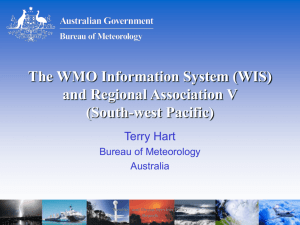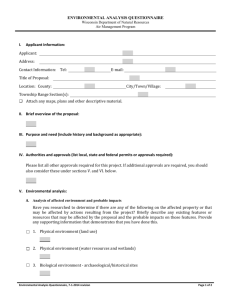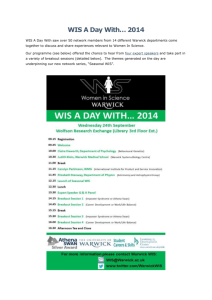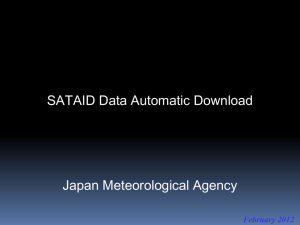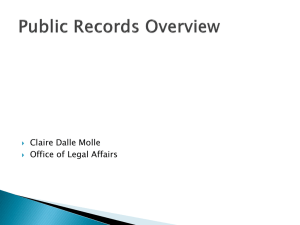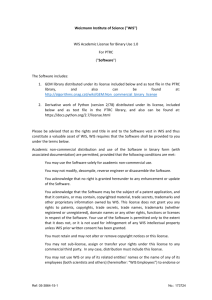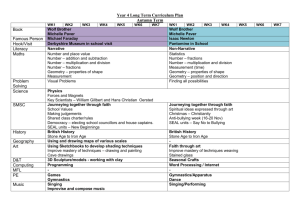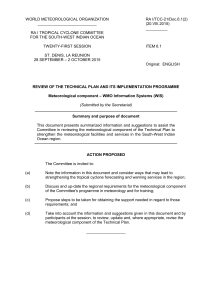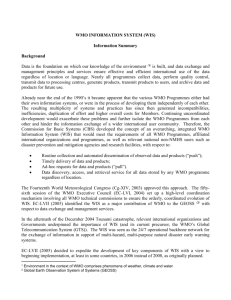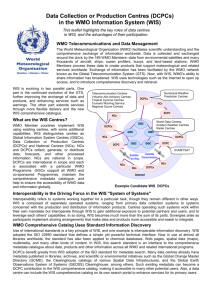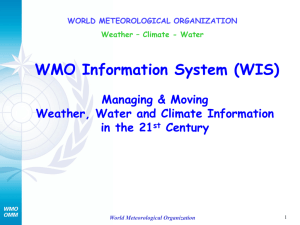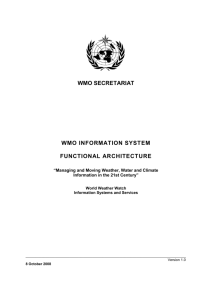Doc. 7.1 ADD.1
advertisement
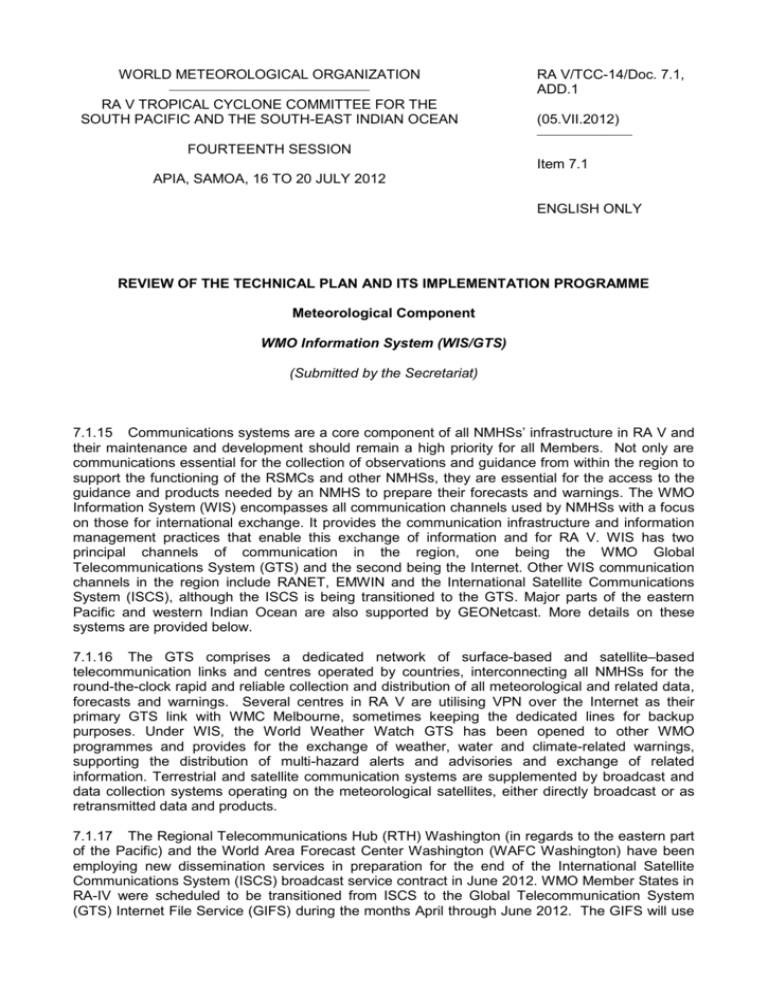
WORLD METEOROLOGICAL ORGANIZATION ________________________________________ RA V TROPICAL CYCLONE COMMITTEE FOR THE SOUTH PACIFIC AND THE SOUTH-EAST INDIAN OCEAN RA V/TCC-14/Doc. 7.1, ADD.1 (05.VII.2012) ___________________ FOURTEENTH SESSION Item 7.1 APIA, SAMOA, 16 TO 20 JULY 2012 ENGLISH ONLY REVIEW OF THE TECHNICAL PLAN AND ITS IMPLEMENTATION PROGRAMME Meteorological Component WMO Information System (WIS/GTS) (Submitted by the Secretariat) 7.1.15 Communications systems are a core component of all NMHSs’ infrastructure in RA V and their maintenance and development should remain a high priority for all Members. Not only are communications essential for the collection of observations and guidance from within the region to support the functioning of the RSMCs and other NMHSs, they are essential for the access to the guidance and products needed by an NMHS to prepare their forecasts and warnings. The WMO Information System (WIS) encompasses all communication channels used by NMHSs with a focus on those for international exchange. It provides the communication infrastructure and information management practices that enable this exchange of information and for RA V. WIS has two principal channels of communication in the region, one being the WMO Global Telecommunications System (GTS) and the second being the Internet. Other WIS communication channels in the region include RANET, EMWIN and the International Satellite Communications System (ISCS), although the ISCS is being transitioned to the GTS. Major parts of the eastern Pacific and western Indian Ocean are also supported by GEONetcast. More details on these systems are provided below. 7.1.16 The GTS comprises a dedicated network of surface-based and satellite–based telecommunication links and centres operated by countries, interconnecting all NMHSs for the round-the-clock rapid and reliable collection and distribution of all meteorological and related data, forecasts and warnings. Several centres in RA V are utilising VPN over the Internet as their primary GTS link with WMC Melbourne, sometimes keeping the dedicated lines for backup purposes. Under WIS, the World Weather Watch GTS has been opened to other WMO programmes and provides for the exchange of weather, water and climate-related warnings, supporting the distribution of multi-hazard alerts and advisories and exchange of related information. Terrestrial and satellite communication systems are supplemented by broadcast and data collection systems operating on the meteorological satellites, either directly broadcast or as retransmitted data and products. 7.1.17 The Regional Telecommunications Hub (RTH) Washington (in regards to the eastern part of the Pacific) and the World Area Forecast Center Washington (WAFC Washington) have been employing new dissemination services in preparation for the end of the International Satellite Communications System (ISCS) broadcast service contract in June 2012. WMO Member States in RA-IV were scheduled to be transitioned from ISCS to the Global Telecommunication System (GTS) Internet File Service (GIFS) during the months April through June 2012. The GIFS will use an HTTPS Internet connection to make products available to authorized users for downloading - all existing WMO RA-IV ISCS users will automatically be assigned a GIFS account. ISCS/WAFS workstation vendors are participating in the transition. NWS plans to incorporate the broadcast of products over the existing NOAA GEONETCast Americas (GNCA) satellite dissemination service in 2013, with a pilot scheduled for the third quarter of 2012. Additional transition information can be found at: http://www.nws.noaa.gov/iscs/countdown.php 7.1.18 The ICAO World Area Forecast System (WAFS) Internet File Service (WIFS) is operationally available for use as the primary means to receive the WAFS data products broadcast over the ISCS. ISCS Aviation Users were being encouraged to complete their transition from ISCS to the WIFS no later than 30 March 2012. Information on WIFS can be found in "The WIFS Users Guide" published in English and Spanish at http://aviationweather.gov/wifs under “Documents”. 7.1.19 The Pacific and East India Ocean RANET utilise a combination of the Internet and commercial satellite distribution systems to send information to countries throughout the region, utilising digital radio broadcasts that can be received by VHF/HF radio and processed by computers. The system allows messages to be exchanged as digital emails where public Internet is not available or cost effective. NOAA also provides the EMWIN service which is also based on a combination of satellite, Internet and radio broadcast services. RANET and EMWIN are essential communication channels for WIS in these regions. 7.1.20 GEONetcast is being provided to the Western Pacific and East Indian Ocean from China’s meteorological satellite. It complements the GEONetcast services from EUMETSAT over the West Indian Ocean and GEONetcast Americas over the Eastern Pacific. Details on CMACast, which is a part of the GTS under the Integrated Data Distribution System (IGDDS), and its contribution to GEONetcast are online at CMA http://www.nsmc.cma.gov.cn/NewSite/NSMC_EN/CMACast/index.html 7.1.21 In addition to the various communication channels, WIS has introduced some new functionality to support discovery, access and retrieval services (DAR) which is based mostly on the Internet and the use of discovery metadata. Just as the use of electronic library catalogues help users of libraries to find books and publications in any library, the role of this service is to allow Members to find what information is circulating on WIS or available from WIS centres, and to provide quick access to current data. 7.1.22 WIS has been operational from January 2012, and has five GISCs (Beijing, Exeter, Offenbach, Tokyo and Toulouse) offering their services. More GISCs are planned to become operational, including Melbourne. GISCs Beijing and Tokyo are also offering Interim Metadata Management Services to allow Members to have access to and manage their metadata while they are waiting on their principal GISCs to become operational. The Manual on WIS (WMO No. 1060) and the update of the Technical Regulations (WMO No. 49) to include WIS have been published. These combined with a Guideline to WIS and guidelines for WMO Metadata for WIS (http://wis.wmo.int) will allow all Members to begin to implement and benefit from the new WIS functionality. It is expected that GISC Melbourne will take the leading role in ensuring Members in RA V also implement and benefit from the new functionality of WIS. 7.1.23 For Members to benefit fully from WIS, it is essential that NMHS implement plans to deploy WIS functionality in their programme plans and that committees such as the RA V Tropical Cyclone Committee work with the GISC Melbourne and WMO Secretariat to ensure their programmes include WIS implementation as a priority activity over this WMO 16th financial period. ______
